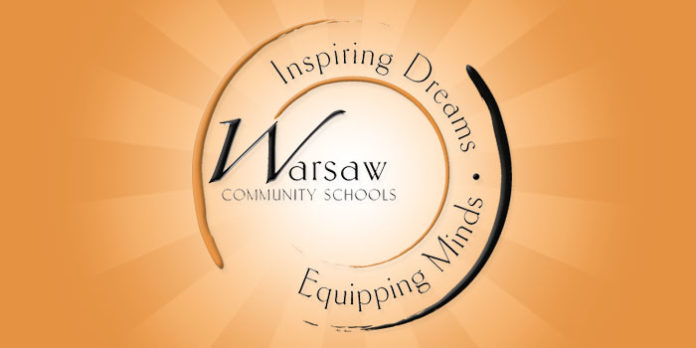While other school corporations in the area have lost hundreds of students over the last 10 years, a demographic study recently completed for Warsaw Community Schools shows its numbers have remained steady, a trend that will likely continue into the foreseeable future.
The study will play a big part in WCS’s 10-year facility study.
“We’ve stayed pretty flatlined here really for the last four to five years. A lot of it has to do with housing, economics, even industry here in town, the workforce. But the good, long-term prognosis is we’re seeing and going to see most likely baseline minimal changes. Upwards, but we’re definitely not going backwards,” said Dr. David Hoffert, WCS superintendent. “The other big piece that comes from it is that while our residential birth rates have gone down, our out-of-district transfers as a school corporation have continued to go up.”
Transfers Rising
When demographer Susan Brudvig, Ph.D, did the study for WCS five years ago, she predicted WCS “would be exactly where we’re at now,” Hoffert said. But the study had two things inverted. It was expected the residential numbers would stay up and the out-of-district student transfers would be minimal. “Really those residential numbers have continued to dwindle because of birth rates, but our out-of-district has skyrocketed. So, again, students are coming from other districts into Warsaw for the opportunities.”
Brudvig also did the demographic study this year for WCS. She was asked to look at specific WCS schools that the school district could have concerns with because of population shifts in the corporation.
Total enrollment for WCS has grown from 6,944 students in 2008-09 to 6,961 in 2018-19, an increase of 17 students. In the same time period, Triton’s has dropped from 1,079 to 909; Tippecanoe Valley’s from 2,151 to 1,783; Wa-Nee’s from 3,127 to 3,056; Wawasee’s from 3,300 to 2,939; and Whitko’s from 1,887 to 1,324. All of those school corporations combined, the student population dropped from 18,488 in 2008-09 to 16,972 in 2018-19, a decrease of 1,516 students, according to the study.
Enrollment at private schools in the area also has dropped recently. From 2017-18 to 2018-19, Lakeland Christian Academy saw its student count drop from 149 to 140; Pierceton Woods, 39 to 38; Sacred Heart, 138 to 132; and Warsaw Christian, 186 to 131.
On the Warsaw numbers, Hoffert said, “We’ve stayed flatlined, and what I mean by that is that between 2008, 2009 and 2018, 2019 we went up 150 students, we went down 150 students. So again, it’s been just kind of this slow bell curve that has taken place over the last 10 years. So that means we’ve stayed relatively neutral.”
He said when you compare Warsaw to the surrounding districts, the other school districts have continually seen student population decrease.
“That trend very much matches Northern Indiana as a whole as we look at it, because population has become very centric around the Indianapolis area, inside of it. That doesn’t mean that there isn’t great industrial growth that is happening. A lot of times it just means that people are having less kids,” Hoffert said.
He said WCS is very happy to see the demographic study numbers and realize that even though Northern Indiana continues to go down in numbers, “We’ve stayed steady through a recession. We’ve stayed steady through industrial changes and local businesses that have come into the community, and we’re continuing to thrive as a school corporation. I believe that’s really because of the choice that we offer and the programming that Warsaw Community Schools has.”
Opportunities Available
Hoffert said he believes the out-of-district transfer student population has risen because people see a lot of opportunity at WCS. “Sometimes we hear that people are driving in for occupation and industry. There definitely are jobs here in Warsaw, so I think more people are driving in from outside, whether that’s even Fort Wayne, South Bend area. Not even just our local schools. Sometimes it’s even a little bit of a farther radius that they’re coming in from.”
He said the other part of it was the “immense amount of choices our students have.” WCS offers over 100 Advanced Placement and Dual Credit courses at the high school. In middle school, Warsaw students can earn high school credit, while at the elementary level there’s dual-language immersion, STEM education and more. “We’re just really proud of the offerings that we have continued to have,” he said.
In 2013-14, WCS had 188 transfer students in. By 2018-19, it had 340 transfers. Now that state money for a student follows the child, those numbers are really important for local schools, Hoffert said. WCS gets about $5,600 per student from the state. With just those 340 transfer students, that’s about $1.9 million in funding from the state.
“The one thing that we do try to manage is, when we take out-of-district transfers, we take them but it is space-dependent. So sometimes somebody will say, ‘I want to go to XYZ school,’ and we say we don’t have room there, but we do have room at these four elementary schools at that grade level,” Hoffert said.
Chief Financial Officer April Fitterling said, “And there’s no charge for them to transfer in. It’s all free.”
The state used to require families pay a school to transfer their student in. Then about in 2011, the state opened it up so schools would be more competitive and schools no longer had to charge for transfers in.
Three Forecasts
The demographic study provides for a base forecast, a high forecast and a low forecast. The base forecast is where Brudvig thinks WCS will end up; the high forecast is if everything worked out “really, really well” for WCS; and the low forecast is a worst-case scenario if the area experiences a multitude of problems in areas such as housing, child care and workforce.
In the base forecast, WCS total student population is predicted to be 6,865 for the 2019-20 school year but reaches 7,430 students by 2029-30. The high forecast starts out with 7,025 students in 2019-20 and ends with 8,815 total students at WCS by 2029-30. The low forecast puts the 2019-20 student population at 6,790 students, and sees it dwindle down to 6,100 by 2029-30. The state’s official student count day is Sept. 15.
“But most likely, when you really look at it, we’ll be at 7,300 kids (by 2029-30),” Hoffert said. “So that means if things stayed very similar over the next 10 years, we need to make sure we’ve provided room for an extra 350 kids.”
Fitterling said, “This is the one (base forecast) you hope it trends like so you don’t have any unforeseen, huge projects that you need to take on that you can’t when you don’t have the dollars to do it. So if you continue to grow in the steady plan that we have, and the financial plan that we are putting forward, this is the steady growth to be able to maintain that.”
A Tale Of Two Schools
The demographic study also looks at individual schools within WCS. Hoffert used Madison Elementary School, on the north end of the district, and Claypool Elementary School, on the south end, as examples.
“Madison right now is growing leaps and bounds because you have all of the residential apartments that are going up. You have the development … and we continue to see Madison grow and we’re predicting, here in the next couple of years, you’re going to see them up around 600 students, which means we’re going to have to figure out what are the relief valves for an area like Madison,” Hoffert said. “At the same time, we have some concerns when we’re looking out at Claypool. Now, the good part is that they’ve bucked the trend, they did a lot of recruiting and selling and they’re up a few more students than what they thought they were going to be going into this year.”
Hoffert credited the quality programming at Claypool for increasing its student population by 20 students. Claypool is doing some “really unique things” around agriculture and STEM education, Hoffert said.
“But this also shows us that, demographically speaking, there’s a shift to the north side of town,” he said.
He said they looked into transfers out of Claypool and into other WCS schools, but found there are no more transfers out of Claypool than any other Warsaw school.
“What is happening though is, the birth rates and just the number of residents on the south side of the county has continued to decline. And when that continues to happen, we have to look at it and, again, that goes into our facility planning of what do we need to do, what are the programming needs that we need to have down at Claypool. Because the last thing we want to be talking about, even five years or 10 years down the road, is what does it look to close a school when we really need to build a school on the north side of town,” Hoffert explained. He did stress that there is no plan to close Claypool.
Facility Study
One of the things many people don’t understand about WCS is how massive it is, Hoffert said. There’s about 7,000 students, 1,200 total employees and 18,000 miles of bus routes daily. Over 30 native languages are spoken.
All the data collected from the demographic study will help WCS with its long-term facility study.
“We wanted to make sure those numbers matched up with what we were looking at: To make sure we had the proper amount of space, that we were doing the right renovations, that we didn’t get caught with a bad circumstance either way – too many kids or not enough kids five years from now. We know that we’ll have to continue to readjust, but it gives us at least a baseline to work off of,” Hoffert said.
For the facility study, WCS asked Performance Services Inc. to look at the next 10 years. This is an update of one Kovert Hawkins did in 2008.
Hoffert said the main goals WCS told Performance Services it wanted was equitable, safe-learning space for all students; places to prepare students for their future not the past; fiscal understanding of the cost and the community impact; and then a continual timeline to make sure WCS is taking care of its facilities.
Ongoing Work
During this past summer, Hoffert said WCS did a lot of work. The high school has a new, bigger cafeteria with a learning staircase scheduled to be completed by Labor Day. The Student Activity Center grand opening is tentatively Oct. 9.
“The biggest thing, because people always say, ‘You’re talking about other renovations at the high school, why did you do that part first?’ It’s, as we’re doing those renovations we’ve got to move the students someplace. This summer, we crunched the time scale as close as you could ever imagine,” Hoffert said. “We’re going to be utilizing this space day in and day out just to be able to shift people around, really over the next five to six years.”
He said they’re not doing it all at the same time because if all the work was completed simultaneously, it would be a tax burden on the community. By spreading the work out over time, debt from other buildings will fall off as other projects are started.
Other work WCS needs to complete includes asphalt work, carpeting and painting at Harrison and Eisenhower, deep cleaning everywhere, HVAC, chillers, boilers and fans, and paneling. While classroom expenditures come out of state funds, building renovations come out of local property taxes.
“So our goal is, when it comes to school property taxes that we keep that level. We’ve stayed far under that,” Hoffert said.
He said WCS also looks at cost-savings opportunities. One thing the school district has learned is that in order to keep Gateway Educational Center – the former Madison school on Union Street – open, it will cost about $10 million in renovations.
“That is not going to be worth it in the long run to do those renovations. It’s a building the same age as (the former) Lincoln,” he said. WCS is working with a number of different community groups and organizations to talk about what the future of that building could look at.
“I think we have some really strong leads, so we’re not talking about immediate closure of the building, but we are talking about, here in the long run, we save on energy costs,” he said. The programming there would be moved to other places in the community.
Another inefficiency is that the WCS maintenance building is not on the main campus, but is a smaller building on East Market Street. Hoffert said WCS is looking at a centralized maintenance building on the main campus where the administration building is located.
At Warsaw Community High School and Warsaw Area Career Center, Hoffert said WCS is looking at a main entry point for the high school, new HVAC units in the classrooms and more up-to-date STEM labs. Classrooms need updated and corridors need connected.
Lakeview Middle School is another big project, but Hoffert said the guts of the building are still very good, which will be a savings to the community in the long run. It needs a better and more secure entryway, as well as updates to the sprinkler system and windows.
“As we talk about these things, I know they sound really simple, but, No. 1 design work is not done. Any estimates that we have are just very, very rough because we can’t even determine what costs will be even five years down the road, but our goal is to stay within those fiscal boundaries that we have and to knock them off piece by piece,” Hoffert said.





